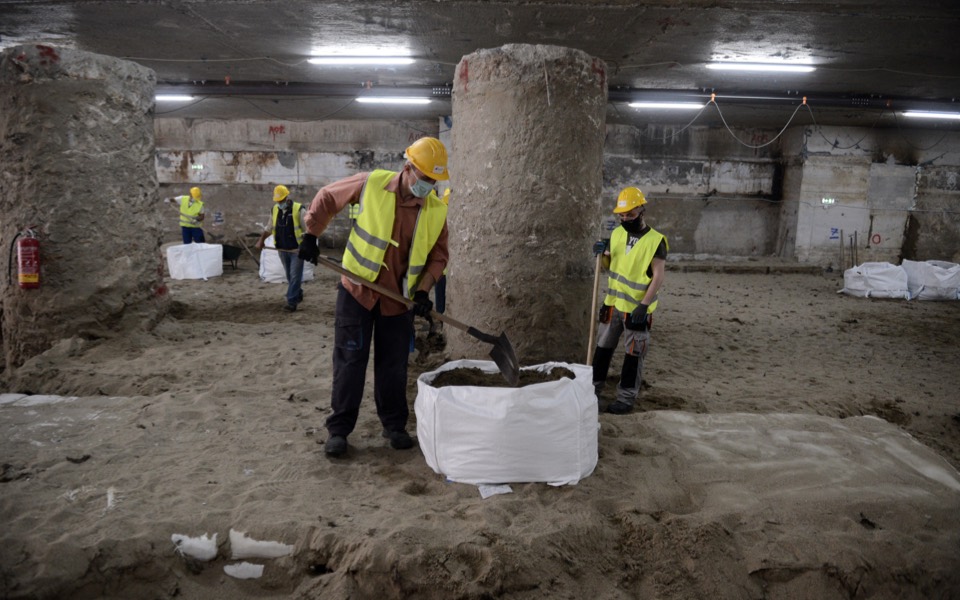Thessaloniki’s Byzantine identity is under threat

Thessaloniki’s uninterrupted history from the 4th century BC to the early 20th century is documented by more than 300,000 finds, both movable and monumental, brought to light by the years-long excavations during the construction of the northern port city’s underground rapid-transit system. The project has provided new elements that are extremely important for urban planning, social life and artistic creation in the area.
During metro construction work at the Venizelos station, the Byzantine-era Decumanus Maximus and Cardo Maximus crossroad was discovered, having survived for 16 centuries. The east-west Decumanus Maximus is a marble paved colonnaded street that crosses the north-south Cardo.
An impressive tetrapylon is located at the intersection of the two streets. The area served as a hub of economic life and the city market. The streets were surrounded by dense building blocks. Workshops making jewelry, metalware, glassware and ceramics and stores were located all along both sides of the streets. Over the centuries the area was embellished with impressive public spaces such as squares, galleries, fountains and nymphaeas, or monuments consecrated to the nymphs.
Thessaloniki was an important commercial, political, military and diplomatic center throughout the Byzantine period of its history, as well as a trade hub for the wider region, accessible both by land and sea.
In 2015 the Central Archaeological Council (KAS) decided the finds should remain in situ, including proper conservation and preservation works. It was also decided the site should be visible through an overpass and a glass floor, with the possibility of controlled public access. The decision foresaw integration with other city monuments, such as those of the Paleochristian and Byzantine eras (the 15 listed as UNESCO World Heritage Sites in 1988), which all together would serve as a diachronic open-air museum. Interpretation and presentation are essential components, of course, of any heritage conservation efforts and means of enhancing public appreciation and understanding of cultural heritage sites.
KAS recently adopted another plan, according to which all finds will be removed from their physical location and reinstalled after the construction of the metro station.
I note that the new plan is not in conformity with UNESCO standard-setting documents – including conventions, recommendations and charters – that exist on the subject of the protection and conservation of cultural heritage.
I strongly believe that any transfer of elements of heritage represents a violation of the principle of preserving heritage in its original context. The surrounding landscape, natural environment and geographical setting are integral parts of a site’s historical and cultural significance and, as such, should be considered in its interpretation. Furthermore, every means must be taken to facilitate the understanding of the monument and to reveal it without distorting its meaning.
The above finds, as a homogeneous monumental group, are of special character because they are interwoven into the urban fabric of the city. For this reason, the removal of any of them signifies a loss of authenticity in form and design, materials and substance, use and function, traditions and techniques, location and setting, spirit and feeling.
The international scientific and intellectual community as well civil society in Greece has mobilized to properly preserve this unique discovery in situ.
As indicated in the Valletta Convention, each party undertakes to reconcile and combine the respective requirements of archaeology and development plans by ensuring that archaeologists participate in planning policies and in the various stages of development schemes.
Cultural heritage constitutes a world heritage whose protection is the duty of the whole international community. As mentioned in Article 12 of the World Heritage Convention, the fact that a property has not been included in the World Heritage List should in no way be construed to mean that it does not have any outstanding universal value.
It is known that the Roman cities (such as Apamea in Syria, Jerusalem and Beit She’an in Israel, Jerash and Gadara in Jordan, Split in Croatia and Herculaneum in Italy) had Decumanus Maximus and Cardo Maximus road systems. UNESCO could support projects for the creation of a thematic cultural route or for their inclusion on the World Heritage list as a serial nomination in case proposals are submitted by the member-states concerned and by Greece (in case of preservation of Thessaloniki’s finds in situ).
As expressed in the Venice Charter, a monument is inseparable from the history to which it bears witness and from its original setting.
Helen Methodiou is an archaeologist and a former vice chairman of the UNESCO World Heritage Committee.



